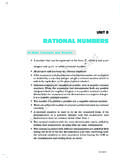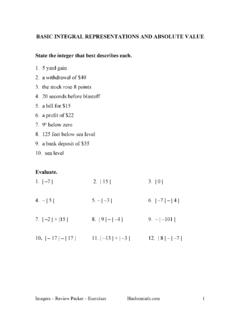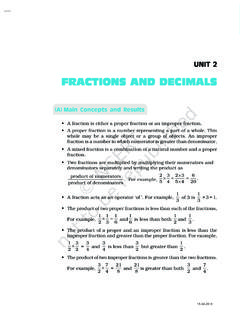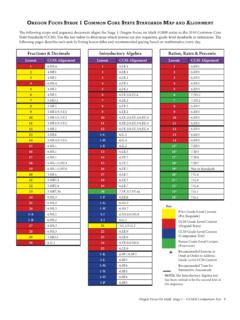Transcription of Rexx Arithmetic
1 rexx Arithmetic -more than just numbersMike CowlishawIBM arithmeticCurrent status Databases Other languages Hardware StandardsRationalizing decimal arithmeticQuestions?Why is decimal Arithmetic important?Decimal Arithmetic represents numbers in base ten, so uses the same number system that people have used for thousands of yearsPervasive for financial andother commercial applications; often a legal requirement55% of numeric data incommercial databases aredecimal (and a further 43% are integers) = 1/10 = 1 x 10 = 1E-1= 1/16 + 1/32 + 1/256 + 1/512 + 1/4096 + 1/8192 + ..Decimal:Binary:-1 The trouble with binaryRepeated division by 10; what users division by 10; what they get:Decimalfloat (binary) exampleWhat does the following code segment display?double a= , b= ; (a); (b); (a/b); // (a%b); // exampleWhat does the following code segment display?double a= , b= ; (a); (b); (a/b); // (a%b); // exampleWhat does the following code segment display?
2 Double a= , b= ; (a); (b); (a/b); // (a%b); // (almost !)Binary floating point is currently essential only where performance is the overriding concern for example, matrix inversions for these cases, use C or Java floatand double typesIn all other cases, use decimal Arithmetic rexx , Object rexx , and NetRexx all do this for you by defaultWhen to use decimals? rexx Arithmetic , 1979-1999 rexx [May 1979]'Minimal' Arithmetic minimum necessary to be useful (loop counters, etc.)Integers onlyThis was a 'holding' implementation, while other parts of the interpreter were designed and implemented rexx [January 1980]Plain decimal Arithmetic (no exponents)Up to 9 digits after the decimal pointPrecision of result is determined by the more precise of the two terms involved in an operationWorked well, but results could often surprise8/3 2 8 the 'new' Arithmetic [May-July 1981]Developed primarily by e-mailInitially controversial (because it changed the behaviour of existing programs)Widely discussed and researched (REX [sic] was in use in 43 countries by then)Essentially the same as the Arithmetic in "The rexx Language" book (1985 & 1990)The choice of arithmeticThe principle:"REX Arithmetic attempts to carry out the usual operations in as 'natural' way as possible.
3 What this really means is the rules which are followed are those which are conventionally taught in schools and colleges."(7 Oct. 1981) rexx Arithmetic [1]Full-function decimal floating point arithmeticPreserves mantissa length, etc. For example, x 2 gives (not )Exact representations, as expected ( )Precision is user-selectable (numeric digits)Exponents from E-999999999 through E+999999999 rexx Arithmetic [2]Robust: all ill-defined or out-of-range results raise errorsIntegers are a seamless subset of all numbersEvolved over 18 years, based on user feedback and requirements (including mathematicians, experts in data processing, financial users, etc.)Numerous public-domain and commercial implementations existANSI (X3-J18) refinementsTrigger to exponential notation after (not dependent on DIGITS setting for numbers less than one)LostDigits condition (raised if input data too precise)Input data rounded to DIGITS (not DIGITS+1)Published as ANSI (see ), refined through 1999 NetRexx arithmeticExactly as ANSI (except that FUZZ setting is not included)Both numeric digitsand numeric formImplemented in the class (therefore usable by all Java programs)Decimal Arithmetic everywhere?
4 Not a new idea .."Fingers or Fists?" (Werner Buchholz, 1959)Unified Decimal Floating-Point (Fred Ris, 1976)Base 10 floating-point, (Tom Hull, 1978) rexx decimal floating point (1979-1999)Radix-Independent Floating-Point (IEEE 854, 1987)Current Status (Databases)IBM DB2: 31 digit packed decimal integers, with implied scaleMicrosoft/Sybase: 38 digit integers, held in binaryOracle: 38 digit bunched decimal floating pointXML: Schema includes (broken) decimal data typeCurrent Status (Languages)C/C++: 15-31 digit fixed decimal supportCOBOL: 31 digit fixed decimal support; the new standard in 2001 will require 32-digit floating pointJava: unlimited floating point decimal support (by IBM)JavaScript/JScript: floating point decimal plannedC#, VB, etc. (Microsoft .Net platform): 28 digit floating point decimal PL/I and VisualAgeGen: as CRexx family: unlimited floating point decimal supportCurrent Status (Hardware)z-Series (IBM S/390): decimal integer instructions (Store-to-Store) are built-inMost non-RISC processors (Intel x86, Motorola 68xxx, etc.)
5 Have decimal adjust instructions to aid decimal integer Arithmetic (not accessible from C)In general, decimal Arithmetic has to be carried out in software; 100x to 1000x slower than hardware (or worse)Current StandardsANSI (Programming Language rexx ) floating point arbitrary precision decimalsIEEE 854-1987 (Radix-Independent Floating- Point Arithmetic ) generalization of IEEE 754, to allow for base-10 fixed precisionRationalizing decimal arithmeticThree specifications: Concrete representation, suitable for hardware or software implementation Base specification: core floating point and integer operations, based on ANSI X3-274 Extended specification: extends the base to comply with IEEE 854 Open specifications; available on the web Decimal representationsFor example: fixed point: integer and scaleFloating point: mantissa and exponent many advantages in the mantissa being an integer123450-22123450 Decimal digit representationBi-quinary ( , Abaci, IBM 650, 74390 TTL Ripple Counter, some 'Nixie' tubes) (Binary Coded Decimal) -4 bits, 8-bit, or 1 character per digitExcess-3 (4 bits/digit, values biased by 3) , , 2-out-of-5, 1-out-of-10, GrayNegadecimal (base -10), needs no sign Multi-digit representationsBase 100 (0-99 in a byte)Base 1000 (0-999 in 10 bits), Chen-Ho, and the new Densely Packed Decimal encodingProbably the optimal decimal-based representationBase 1,000,000,000 (0-999999999 in 32 bits)Big Integer (mantissa is a pure binary integer).
6 This needs fast algorithms for multiplying or dividing by powers of 10 Concrete representations64-bit (3 flags, 11 exponent, 50 integer), 3+15 digits128-bit (3, 15, 110), 4+33 digitsExponent is biased binary; integer is 3-in-10 Densely Packed Decimal123450-2123450-2 Object-oriented design conceptArithmetic operations depend on:numbers (many instances)the context in which operations are carried out (usually implied, and relatively global) This is mirrored by objects:a class that holds (decimal) numbersa small context class, which provides information such as precision and rounding modeThe IBM implementation for JavaTMBCD (byte/digit). Function upwards-compatible with documented; implementation is open source and available from: through Java Community Process to integrate into the Java Core, using the (BigInteger + scale) representationExample - Compound Interest$100,000 at for 20 * Java program to calculate compound interest */import *;public class compound{ public static void main(String arg[]){ MathContext def= ; BigDecimal start=new BigDecimal(100000); BigDecimal years=new BigDecimal(20); BigDecimal rate =new BigDecimal(" "); // ( ) BigDecimal total; total= (years,def).}}
7 Multiply(start,def); ("Final value ="+ ()); }}Other users of rexx arithmeticDB2 databaseCOBOL, PL/I, Language EnvironmentECMA/Microsoft VB, C#, and .Net (subset)JavaScript/JScript (ECMAS cript)Hardware proposal at IEEE Arith15 (June 2001)(in progress)SummaryBinary Arithmetic will continue to be used Decimal data and Arithmetic predominateRexx decimal Arithmetic is well understood, standardized, and quite possibly could become the standard arithmeticNative decimal datatypes are already in many languages (COBOL, PL/I, rexx , C# ..); once hardware support is available this will accelerateQuestions?







